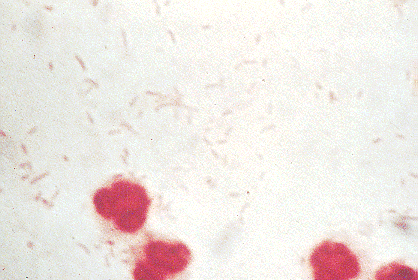HAEMOPHILUS
HAEMOPHILUS
The Haemophilus genus represents a large group of Gram-negative rods that like to grow in blood.
The blood medium provides two factors which many Haemophilus species require for growth:
X factor and V factor. Sometimes Haemophilus is cultured using something called the "Staph streak"
technique. In this procedure, both Staphylococcus and Haemophilus organisms are grown
together on blood agar. Haemophilus colonies will usually form small colonies called "satellites"
around Staphylococccus colonies because Staph can provide the necessary factors required for
optimium Haemophilus growth. Morphologically, Haemophilus bacteria usually appear as tiny
coccobacilli under the microscope, but they are included with the Pleomorphic bacteria because of the many
shapes they assume. A methylene blue stain of a smear can also help with identification. Haemophilus
species are classified by their capsular properties into six different serological groups, (a-f). Species
which possess a type b capsule are clinically significant because of their virulent properties.
H. influenzae
(under the microscope)
 Infection by H. influenzae is common in children and its name may lead you to conclude that it is the
causative agent of the flu. Actually, this bacterium causes a secondary respiratory infection that usually
inflicts those who already have the flu. This species may exist with or without a pathogenic
polysaccharide capsule. Although both strains occur as natural flora of the nose and pharynx, they can
confer severe illness in patients that are immunosuppressed or that have pre-existing respiratory
ailments. Strains that lack the capsule usually cause mild localized infections (otitis media, sinusitis),
as opposed to the type b encapsulated strain of H. influenzae that can cause several serious infections.
Most of these infections occur in unvaccinated children less than five years of age because they have not yet formed
antibodies against the bacterium. H. influenzae infection can lead to a variety of diseases:
Infection by H. influenzae is common in children and its name may lead you to conclude that it is the
causative agent of the flu. Actually, this bacterium causes a secondary respiratory infection that usually
inflicts those who already have the flu. This species may exist with or without a pathogenic
polysaccharide capsule. Although both strains occur as natural flora of the nose and pharynx, they can
confer severe illness in patients that are immunosuppressed or that have pre-existing respiratory
ailments. Strains that lack the capsule usually cause mild localized infections (otitis media, sinusitis),
as opposed to the type b encapsulated strain of H. influenzae that can cause several serious infections.
Most of these infections occur in unvaccinated children less than five years of age because they have not yet formed
antibodies against the bacterium. H. influenzae infection can lead to a variety of diseases:
- Meningitis- H. influenzae is the most common cause of bacterial meningitis in children
between the ages of five months and five years.
The initial respiratory infection can spread to the blood stream and eventually the central nervous system.
A stiff neck, lethargy, and the absence of the sucking reflex are common symptoms in infected babies.
A vaccine is available, but is not always effective in very young children.
Adult meningitis is much less common and usually only occurs in those predisposed to illness.
- Epiglottitis- H. influenzae is the number one cause of this potentially fatal disease, which
may cause airway obstruction in children between the ages of 2 and 4.
- Haemophilus infection has also been associated with chronic bronchitis, pneumonia, bacteremia,
conjuctivitis, and a host of other illnesses.
For serious infections, third generation cephalosporins are the drug of choice. Resistance may develop
when ampicillin is used in treatment.
OTHER SPECIES
H. aegyptius
This bacterium is biochemically identical to H. influenzae. It is known to cause pinkeye
(conjuctivitis) and is spread very easily, especially among children.
H. ducreyi
Chancroid, a sexually transmitted disease characterized by painful genital ulcers, is associated with this
bacterium. H. ducreyi does not require the V factor for growth nor does it ferment glucose.




Copyright © 1995 University of Texas - Houston Medical School, DPALM MEDIC, All rights reserved.
 Infection by H. influenzae is common in children and its name may lead you to conclude that it is the
causative agent of the flu. Actually, this bacterium causes a secondary respiratory infection that usually
inflicts those who already have the flu. This species may exist with or without a pathogenic
polysaccharide capsule. Although both strains occur as natural flora of the nose and pharynx, they can
confer severe illness in patients that are immunosuppressed or that have pre-existing respiratory
ailments. Strains that lack the capsule usually cause mild localized infections (otitis media, sinusitis),
as opposed to the type b encapsulated strain of H. influenzae that can cause several serious infections.
Most of these infections occur in unvaccinated children less than five years of age because they have not yet formed
antibodies against the bacterium. H. influenzae infection can lead to a variety of diseases:
Infection by H. influenzae is common in children and its name may lead you to conclude that it is the
causative agent of the flu. Actually, this bacterium causes a secondary respiratory infection that usually
inflicts those who already have the flu. This species may exist with or without a pathogenic
polysaccharide capsule. Although both strains occur as natural flora of the nose and pharynx, they can
confer severe illness in patients that are immunosuppressed or that have pre-existing respiratory
ailments. Strains that lack the capsule usually cause mild localized infections (otitis media, sinusitis),
as opposed to the type b encapsulated strain of H. influenzae that can cause several serious infections.
Most of these infections occur in unvaccinated children less than five years of age because they have not yet formed
antibodies against the bacterium. H. influenzae infection can lead to a variety of diseases:



